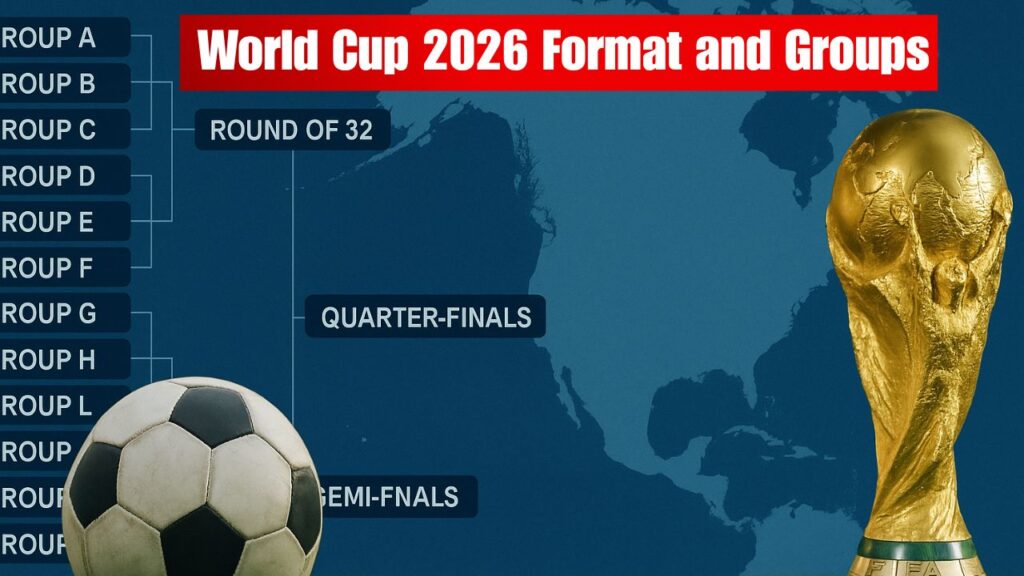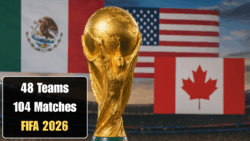The 2026 FIFA World Cup will be the most expansive tournament in the history of football, featuring 48 national teams competing across three host nations — the United States, Canada, and Mexico. With this new structure, fans around the world can expect more matches, new rivalries, and an extended knockout stage that will redefine the global competition. This edition not only expands the number of games but also changes how the group format and knockout stages are organized, ensuring a more inclusive and exciting experience for players and supporters alike.

New Group Stage Format for the 2026 FIFA World Cup
The group stage format of the 2026 FIFA World Cup will feature 12 groups of four teams each, replacing the traditional 32-team setup used in previous editions. Each group will play a round-robin format, where every team faces the other three once. The top two teams from each group, along with the eight best third-placed teams, will advance to the Round of 32. This means the tournament will now have more matches and greater chances for emerging nations to make an impact. The new structure ensures fairness while maintaining competitive balance across the global stage.
Knockout Stages and Match Progression
Following the group phase, the competition will move into an expanded knockout stage that begins with the Round of 32. From there, it will follow the traditional elimination pattern — Round of 16, Quarterfinals, Semifinals, and the Grand Final. With 104 matches in total, fans can expect an action-packed month filled with drama, last-minute goals, and unforgettable moments. The new format offers more opportunities for nations to progress and creates a more unpredictable tournament path. This change reflects FIFA’s vision to make football more global and competitive than ever before.
Host Country Allocation and Match Distribution
The 2026 World Cup will be hosted across North America, marking the first time three countries will jointly host the event. The USA will host 60 matches, including all games from the quarterfinals onward. Meanwhile, Canada and Mexico will each host 10 matches during the group stages. This distribution not only shares the excitement of hosting but also highlights the diverse football cultures across the continent. Fans will experience the World Cup in iconic cities like Los Angeles, Toronto, and Mexico City — each adding its unique energy to the global celebration of football.
Complete Overview of 2026 FIFA World Cup Structure
The upcoming World Cup represents a major evolution in tournament design. By increasing participation to 48 teams, FIFA aims to include more nations while ensuring top-quality football entertainment. With the combination of expanded groups, a longer knockout phase, and a tri-nation hosting model, this edition will set new standards for future tournaments. The scale and ambition of the 2026 event underline the growing reach of the sport and the goal to make football accessible to all corners of the world.
| Category | Details |
|---|---|
| Total Teams | 48 National Teams |
| Number of Groups | 12 Groups (4 Teams Each) |
| Total Matches | 104 Matches Across 3 Nations |
| Host Countries | USA, Canada, and Mexico |
| USA Matches | 60 (Including Final & Semi-Finals) |
| Canada & Mexico Matches | 10 Each (Group Stage) |
FAQ 1: How many teams will compete in the 2026 FIFA World Cup?
A total of 48 national teams will compete in the 2026 tournament.
FAQ 2: Which countries are hosting the 2026 FIFA World Cup?
The USA, Canada, and Mexico will jointly host the 2026 FIFA World Cup.
FAQ 3: How many matches will be played in total?
The 2026 World Cup will feature 104 matches across three host countries.
FAQ 4: What is new about the World Cup format?
The tournament will introduce 12 groups of four teams, expanding the knockout rounds to include 32 teams.





